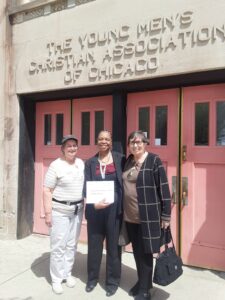 The second floor of The Renaissance Collaborative building in Chicago, IL. holds a portal to the past. The former YMCA building has seen a rebirth as a support service and assisted housing location for Chicagoans in need. As with all old buildings, some things work and some things don’t. The entryway elevator is no exception and falls to the not working aspects of old building renovation projects. However, when the National Board visited the location back in Spring of 2023, they gleefully climbed the ancient-marble stairs and in so doing were immersed in the embrace of a building that shared her history and ongoing legacy.
The second floor of The Renaissance Collaborative building in Chicago, IL. holds a portal to the past. The former YMCA building has seen a rebirth as a support service and assisted housing location for Chicagoans in need. As with all old buildings, some things work and some things don’t. The entryway elevator is no exception and falls to the not working aspects of old building renovation projects. However, when the National Board visited the location back in Spring of 2023, they gleefully climbed the ancient-marble stairs and in so doing were immersed in the embrace of a building that shared her history and ongoing legacy.
In 1913 the Wabash YMCA opened and by design went on to act as the first YMCA in the Midwest to serve people of color. The historic building was the heart of cultural and economic progress for African Americans in the Bronzeville region of Chicago for over half a century and is hailed as the birthplace of Black History Month.
Over the years, the facility has hosted sports, educational, and cultural events that supported the local community through the use of its basketball court, swimming pool, community rooms, and apartments. Big name acts such as the Harlem Globetrotters performed in the gymnasium in the 1940’s. The mural Mind, Body, and Spirit by William Edouard Scott, painted in 1936, (pictured on next page), was saved from demolition by The Renaissance Collaborative during their ongoing renovations. Today the mural serves as hope and inspiration for the formerly homeless residents as they work toward obtaining self-sufficiency.
 To speak of the building as a singular entity illustrates the community’s dedication for the structure but still, the cultural changes brought on after World War II changed society in many ways. Hard times were felt in the 1960’s and in 1969, the YMCA was closed and shuttered. In 1982 the Wabash YMCA was sold to neighboring St. Thomas Episcopal Church for one dollar.
To speak of the building as a singular entity illustrates the community’s dedication for the structure but still, the cultural changes brought on after World War II changed society in many ways. Hard times were felt in the 1960’s and in 1969, the YMCA was closed and shuttered. In 1982 the Wabash YMCA was sold to neighboring St. Thomas Episcopal Church for one dollar.
In 1992, St. Thomas Episcopal, Apostolic Faith Church, Quinn Chapel AME, and St. Elizabeth Catholic Church formed an ecumenical partnership to save the Wabash Y from demolition, naming their partnership “The Renaissance Corporation.” Led by Patricia Abrams, these partners raised nearly $11 million to restore the building.
Ms. Abrams herself provided the ECW women with colorful stories of the renovation of the building along with a walking tour of the grounds. During the Board’s visit Province V representative Ms. Jan Goossens and NECW president Ms. Karen Patterson presented Ms. Abrams with a grant check for $1000. The funding will go to helping the nonprofit continue its legacy of supportive housing, workforce development, black history preservation, environmental sustainability, and community development. The Renaissance uses an asset-based approach to community development, focusing on identifying and building upon a person’s strengths rather than focusing on their weaknesses. By instilling a sense of self-worth and promoting holistic wellness, their ultimate goal is to restore lives. Located onsite are 101 single-resident-occupancy apartments for formerly homeless adults. Residents are provided with a cost-effective means to afford their rent along with education and skills training to ensure their success in society. Although residents are able to stay as long as needed, services are intended to increase a resident’s income and independence so they can successfully re-enter the community.
Senior Village 1 is a 71-unit independent living facility for low-income seniors. The mission of Senior Village is to foster an empowering environment where seniors are active, healthy participants in the community, achieving their full potential and maximizing their quality of life. Located in Senior Village is a geriatric Health & Wellness Center open to all residents and local seniors.
The Renaissance Collaborative Senior Village is a founding partner of the University of Chicago’s Southside Healthy Aging Resource Experts (SHARE) Network—a robust, engaged network of older adults, caregivers, primary care providers and aging specialists who share resources and education to improve health for older adults on Chicago’s South side. Due to this partnership, numerous aging specialists have recently visited TRC Senior Village, offering health presentations on medication management, arthritis, heart health, and physical activity.
In July of this year, Ms. Abrams retired from The Renaissance Collaborative. Her transition from leader to observer is not without a glimpse into how she sees future generations passing though the old Wabash YMCA building. In her announcement she went on to say, “The torch is now yours to empower folks and make a continued and lasting impact on our beloved Bronzeville community.”
